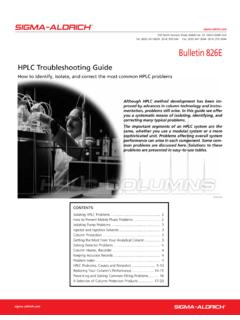Transcription of INSULIN˜INJECTION˜ KNOW-HOW
1 INSULIN INJECTION KNOW-HOW . Learning How to Inject Insulin Now that you've made the move to insulin therapy, it won't be long before you start enjoying better blood glucose (blood sugar). management, more energy and a host of other benefits. The prospect of taking insulin nerve endings in this area, 0-1- injections may have you feeling a so injections are usually bit anxious. That's OK! Just painless. There are a num- about everyone feels that way. ber of options for adminis- Just know that your anxiety will tering insulin: vanish soon enough. Here are some valuable facts and tips to syringes .
2 Help make your transition to Disposable plastic insulin insulin smooth and easy. syringes are still widely used, but the popularity WAYS TO GIVE INSULIN of pens and pumps (see Because insulin is broken down next page) is growing. by digestive enzymes, it cannot syringes vary in terms of be taken in pill form. Instead, it is how much insulin they hold as well delivered with a syringe into the as the length and thickness of the layer of fat below the skin, also needle. syringes can be used to called the subcutaneous tissue. deliver insulin directly into the layer 0- 1- The layer of fat on the stomach, of fat below the skin, or they can 0-1- hips, thighs, buttocks and backs of inject insulin into a temporary the arms are common sites for port that sits on the skin.
3 The injecting insulin. From there, the port, which is changed every 2-3. insulin absorbs into the blood- days, features a small flexible stream where it circulates to the plastic tube that sits below the skin. cells throughout the body. A needle is used to place the tube The really good news about deliver- under the skin, so only one needle ing insulin into the layer of fat stick is required every 2-3 days below the skin is that there are no when a port is used. 1 | C. opyright 2020 Association of Diabetes Care & Education Specialists. All rights reserved. Supported by an Reproduction or republication strictly prohibited without prior written permission.
4 Educational grant from BD. insulin injection KNOW-HOW learning how to inject insulin PUMPS. Insulin pumps are electronic devices that are worn continuously and deliver insulin into the fat layer below the skin by way of a flexible 0- 1- plastic tube (similar to the port . 0-1- described above). Insulin pumps are popular among those who require multiple daily injections of insulin. Safe and successful use of a pump requires considerable education and training, and their cost can be INS. relatively high. Insulin pumps are PENS not typically used by those who are Insulin pens got their name because new to insulin, but can be an effec- they are about the size and shape tive option once you have a bit of a writing pen.
5 They contain more experience. insulin (instead of ink) and have a dial for setting the dose. A dispos- able pen needle is attached to the end of the pen prior to injecting. As was the case with syringes , pen needles are available in a variety of lengths and thicknesses. Because they cut down on medical waste and are considered by most to be more convenient, accurate and easy to use than syringes , insulin pens are growing in popularity among people of all ages. 2 | C. opyright 2020 Association of Diabetes Care & Education Specialists. All rights reserved. Supported by an Reproduction or republication strictly prohibited without prior written permission.
6 Educational grant from BD. insulin injection KNOW-HOW learning how to inject insulin CHOOSING AN INJECTION The needles on syringes vary as DEVICE well. Syringe and pen needles as The decision to use syringes or short as 4mm and as long as pens is a personal one. If you have are available. Thickness is measured an opportunity to sample both at in gauge. The higher the gauge, the your healthcare provider's office, thinner the needle. Gauges as high certainly do so. It is best to speak as 32 and as low as 28-gauge can with your healthcare provider and be obtained. In general, it is best to check with your diabetes care team use the shortest, thinnest (highest to find out what is covered under gauge) needles available.
7 Skin your plan. thickness doesn't vary much from person to person. Even if you are Most pens hold 300 units of insulin considered overweight or obese, it and allow delivery of up to 60 to 80. is unlikely that you will need a units at a time. Prefilled dispos- needle longer than 6mm. Needles able pens deliver in single-unit that are too long may produce increments. Durable pens utilize painful intra-muscular injections, replaceable/ insulin cartridges, and with insulin absorbing faster than it may deliver insulin in 1/2 unit incre- should. ments. Pens can be used to deliver a variety of long-acting and rapid- acting insulin types, as well as premixed insulin formulations.
8 Disposable syringes hold up to 100. units per injection. If you decide to use syringes , select a type that holds enough to cover your largest dose with a little room to spare. The markings on a syringe allow dosing in 2-unit, 1-unit, or 1/2-unit incre- ments. Once you have a size that meets your needs, select a type that allows you to dose as precisely as possible. 3 | C. opyright 2020 Association of Diabetes Care & Education Specialists. All rights reserved. Supported by an Reproduction or republication strictly prohibited without prior written permission. educational grant from BD.
9 Insulin injection KNOW-HOW learning how to inject insulin amount of air that is equal to your insulin dose. The TIP of the black plunger should INJECTION TECHNIQUE correspond to the number on the syringe. Technique is everything when it comes to Inject air into the vial: Hold TION KNOW-HOW . making insulin injections easy. the syringe like a pencil and insert the needle into the TO DRAW ONE TYPE OF INSULIN rubber stopper on the top of INTO A SYRINGE: the vial. Push the plunger down Gather your insulin supplies: until all of the air is in the bottle. Get your insulin vial and a fresh This helps to keep the right syringe.
10 Check the insulin vial to amount of pressure in the bottle make sure it is the right kind of and makes it easier to draw up insulin and that there are no the insulin. clumps or particles in it. Also Draw up the insulin into the make sure the insulin is not syringe: With the needle still being used past its expiration in the vial, turn the bottle and date. syringe upside down (vial above Gently stir intermediate or syringe). Pull the plunger to fill premixed insulin: Turn the the syringe to the desired bottle on its side and roll it amount. between the palms of your Check the syringe for air hands.








